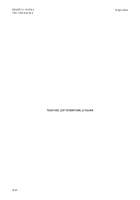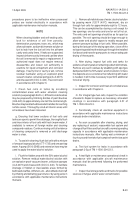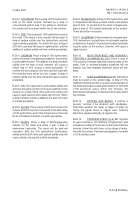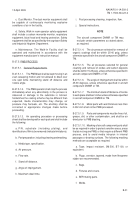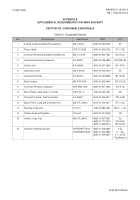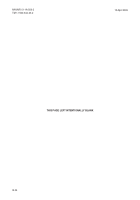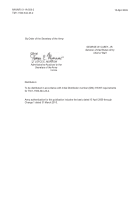TM-1-1500-344-23-2 - Page 232 of 240
B-30
NAVAIR 01-1A-509-2
TM 1-1500-344-23-2
15 April 2009
B-27.3.2. Media used on ferrous alloys shall not be
used on parts made of aluminum, magnesium, or
titanium.
B-27.3.3.
Media having a high density level of 200 parts
per million (ppm) or more of any type of contamination
can cause mechanical damage. Purge and dispose of
contaminated media.
CAUTION
PMB with heavily contaminated media may
permanently damage substrate surfaces.
B-27.4. EQUIPMENT REQUIREMENTS.
B-27.4.1.
General.
a. PMB equipment used to remove organic coatings
from aircraft components shall be a direct pressure feed
abrasive blasting unit capable of propelling a controlled
and continuous stream of plastic media from 15-40 psi
and 0-500 pound per hour media flow. The equipment
shall be equipped with setting indicators and regulation
devices. A blast cabinet (glove box) or walk-in type
facility may be used.
b. Siphon fed abrasive blasting equipment shall not
be used for plastic media blasting.
c. PMB equipment shall have a recovery system,
consisting of a cyclone separator, a rotary airlock, a
magnetic particle separator, and a screen separator.
The recovery system shall be capable of producing
media cleanliness levels as described in B-27.4.1.f.
Alternate recovery system configurations require
engineering approval prior to use.
d. The blast cabinet or walk-in facility shall have
lighting capable of producing a minimum of 55 foot
candles illumination at the work surface. Portable lighting
may be used to eliminate shadows at the work surface.
All lighting shall meet the requirements of the National
Electric Code for Class II Division 1 locations (dust
ignition proof). Reference Army Regulation 11-27.
e. Nozzles shall be venturi type,
1
⁄
4
to
1
⁄
2
inch in
diameter, constructed of a material with an abrasive
resistant characteristic of tungsten carbide or better.
f. PMB equipment shall be capable of maintaining
acceptable levels of media size per MIL-P-85891 and
cleanliness of 200 parts per million or less of heavy
particle contamination.
g. Compressed air supply to the PMB equipment
shall be dry and filtered, 60% maximum relative humidity.
Dedicated source is recommended.
h. Preventative maintenance shall be in accordance
with the manufacturer's recommendations, including
allowable nozzle ID wear. Annual PM program for the
PMB equipment shall include replacing worn nozzles,
lines, and valves; recalibrating pressure and flow gages
on the equipment; and re-certification for full capability
for the intended PMB operation.
i. Equipment certification shall include calibration
of air pressure gages, verification of pressure at nozzle
exit, and flow rate.
j. Re-certification shall be required of any equipment
that was repaired or is deemed responsible for failure to
produce consistent results, including supply air, operator,
or media deficiencies, prior to returning to production.
k. There shall be sufficient PMB units to support the
PMB operations so that processing Ferrous Alloys,
Titanium, Magnesium, Thorium, etc., are each done in
their own dedicated separate units (designed for that
purpose), different from the units used for all other work.
If this is not feasible, the media shall be completely
purged when switching between these different
processes.
B-27.4.2.
Glove Box Cabinet Type Equipment. Glove
Box Cabinets shall be specifically designed for use with
plastic media meeting the general requirements above.
All aircraft component parts shall be processed using
the Glove Box Cabinets unless the equipment is not
capable or the part will not properly fit inside the cabinet.
B-27.4.3.
Walk-In Facility. This processing is
authorized when the part or component exceeds the
size limitations of the Glove Box Cabinet. The Walk-In
Facility (open blasting), in addition to the general
requirements, shall meet the requirements of
OSHA 29CFR1910.9:
a. Ventilation. A minimum cross-draft ventilation
rate of 75 cubic feet/minute per square foot of open face
area shall be provided.
b. Dust Collector. The dust collector system shall be
capable of removing 99.97% of the particles 0.3 (three
tenths) micron or greater in size from re-circulation
systems.
Back to Top

